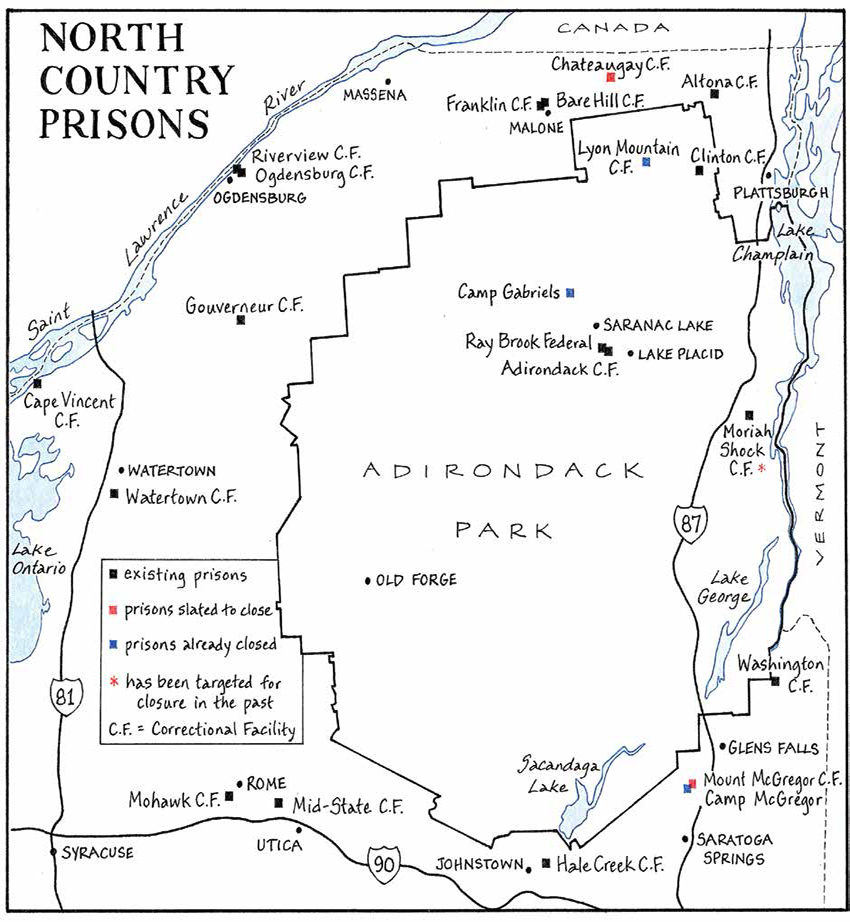Since 1973, New York’s Rockefeller drug laws have put over 150,000 New Yorkers behind bars for nonviolent drug offenses. [ref] Drucker, “Population Impact of Mass Incarceration under New York’s Rockefeller Drug Laws.” [/ref] The tough-on-crime attitudes of state lawmakers at the time have created a lasting legacy in the North Country, where many prisons were built to accommodate the skyrocketing incarcerated population. By converting towns that once relied on logging, mining, and tourism into “one of the largest prison complexes in the United States,” the New York State Corrections Department became the largest employer in the North Country. [ref] Mann, “Hard Times in ‘Siberia.’” [/ref] For towns like Moriah, which once were supported by the iron industry that Alice Green’s father worked in, prisons brought stability to communities in “economic devastation.” [ref] Ibid. [/ref] However, prisons have taken a toll on rural Adirondack communities as well as communities elsewhere in the state.

Source: Drucker, “Population Impact of Mass Incarceration under New York’s Rockefeller Drug Laws.”Laws: an Analysis of Years of Life Lost.
Prisons in the North Country—and around the U.S.—incarcerate a staggeringly high proportion of people of color. While Blacks and Latinos only make up 33% of the population of New York State, they represent over 94% of those behind bars because of the Rockefeller drug laws. [ref] Drucker, “Population Impact of Mass Incarceration under New York’s Rockefeller Drug Laws.” [/ref] According to the Albany-based Center for Law and Justice founded by Dr. Green, the policies and practices of the criminal justice system in the state “have a disproportionately adverse impact on people of color”. [ref] Green, “The Disproportionate Impact of the Criminal Justice System on People of Color in the Capital District.” [/ref] Michelle Alexander has described mass incarceration in America as “the new Jim Crow”, [ref] Alexander, The New Jim Crow. [/ref] as it creates a “racial caste system that suppresses people of color in much the same manner as slavery in the seventeenth, eighteenth, and nineteenth centuries, and Jim Crow laws in the post-Civil War years”. [ref] Green, “The Disproportionate Impact of the Criminal Justice System on People of Color in the Capital District.” [/ref] Alexander points out that more African Americans are under the control of the criminal justice system today than were enslaved in 1850, and that the criminal justice system continues to deny African Americans equal access to housing, education, employment, and voting rights by labeling many of them as felons. [ref] Alexander, The New Jim Crow. [/ref]
While a mass incarceration system clearly harms communities of color, rural communities also have complicated relationships with prisons. Across the U.S., the majority of prisoners are housed in rural areas while most come from metropolitan areas, making prisons a “growth industry” across rural America that is itself “dependent on the continuation of crime-producing conditions”. [ref] Huling, “Building a Prison Economy in Rural America.” [/ref] Yet while prisons do bring jobs to rural communities that often badly need them, they often do not provide the community benefits they promise and even undercut local economies by displacing low-wage workers when inmates are put to work for wages as low as 42 cents per hour. Prisons also do not often encourage the growth of secondary industries to supply them with goods and services, and make rural economies dependent on a single industry. [ref] Ibid. [/ref] According to environmental groups, prisons do not even “capitalize on the special qualities of the Park.” [ref] Mann, “Hard Times in ‘Siberia.’” [/ref] Governor Andrew Cuomo has sought to reduce the dependence of rural economies on prisons, stating that “if people need jobs, let’s get people jobs. Don’t put other people in prison to give some people jobs. That’s not what this state is all about, and that has to end.” [ref] Ibid. [/ref]
Take a look at some of the stories from the Prison Time Media Project to hear about the criminal justice issues that communities across the Adirondack region have been dealing with in the last several years:

Map by Nancy Bernstein. Source: Mann, “Hard Times in ‘Siberia.'”